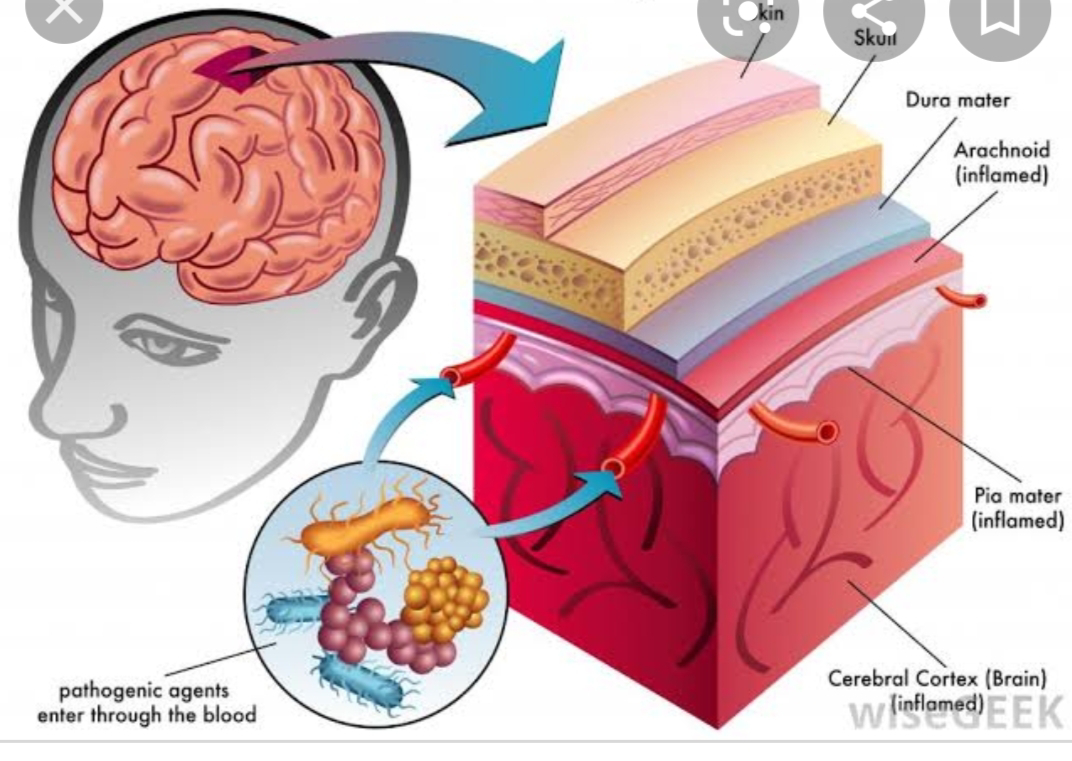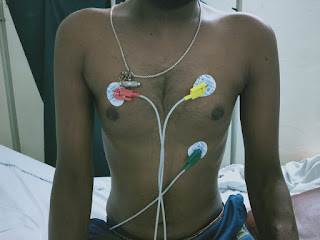VANDANA REDDY
1.55 year old man with Recurrent Focal Seizures
Detailed patient case report here: http://ushaindurthi.
1.What is the problem representation of this patient and what could be the anatomical site of lesion ?
A. Patient presented with right sided hemiparesis with multiple episodes of focal seizure involving right upper limb and lower limb with up rolling of eyes followed by gtcs,lesion might be in left parietal area(cerebral cortex) and seizures due to infarct.
2.Why are subcortical internal capsular infarcts more common that cortical infarcts?
Sub cortical internal capsule infarcts caused by occlusion of a penetrating artery from a large cerebral artery, most commonly from the Circle of Willis. These penetrating arteries arise at sharp angles from major vessels and are thus, anatomically prone to constriction and occlusion. So these infarcts are more common than cortical infarcts.
4. What is your take on the ecg? And do you agree with the treating team on starting the patient on Enoxaparin?
ST depressions noted in precordial leads V1 to V6
Yes , i agree with the treating team on starting the patient on Enoxaparin.
5. Which AED would you prefer?
If so why?
Please provide studies on efficacies of each of the treatment given to this patient.
Pulmonary function abnormalities resulting from obesity
5. Do you agree with the treating team on starting the patient on antibiotics? And why? Mention the efficacies for the treatment given.
41 year old man with Polyarthralgia
Case details here: https://
1.How would you evaluate further this patient with Polyarthralgia?
3. What are the treatment regimens for a patient with RA and their efficacies?3)Treatment regimens:
1.What are your differentials for this patient and how would you evaluate?
-Transfusion related acute hepatic injury (TRAHI)
-Post transfusion hepatitis
-Ischemic hepatitis
coombs testing
antibody panel testing
Treatment is only supportive management with no role of udiliv as the cause for hepatitis is self resolving with increased about of bilirubin due to destruction of rbc as substrate for hepatitis.
2. What are the factors contributing to her uncontrolled blood sugars?
4. What do you think is the cause for her hypoalbuminaemia? How would you approach it?
The potential causes of hypoalbuminemia are many, and include:
Hepatic failure (failure of albumin synthesis)
Gastrointestinal protein loss (protein-losing enteropathy)
Renal protein loss (protein-losing nephropathies)
Other external losses in exudate or hemorrhage
Hyperglobulinemia (with a 'compensatory' decrease in albumin production)
Starvation/protein malnutrition
Chronic illness
Hypoadrenocorticism
Laboratory error
the cause in this patient can be attributes to malnutrition or albumin as acute phase reactant
5. Comment on the treatment given along with each of their efficacies with supportive evidence.
- Piptaz & clarithromycin : for his right upper lobe pneumonic consolidation and sepsis
- Egg white & protien powder : for hypoalbuminemia
- Lactulose : for constipation
- Actrapid / Mixtard : for hyperglycemia
- Tramadol : for pain management
- Pantop : to prevent gastritis
- Zofer : to preventvomitings -
- Question 5
- 5.56 year old man with Decompensated liver disease
Case report here:https://appalaaishwaryareddy.blogspot.com/2020/11/56year- old-male-with-decompensated. html
1. What is the anatomical and pathological localization of the problem?Liver : Chronic liver disease (cirrhosis) secondary to HBVKidney : AKI on CKD (Hepatorenal syndrome) , HyperkalemiaGI : GAVE , portal hypertensive gastropathyLung : pneumonia , pleural effusion
2. How do you approach and evaluate this patient with Hepatitis B?
3. What is the pathogenesis of the illness due to Hepatitis B?
4. Is it necessary to have a separate haemodialysis set up for hepatits B patients and why?
Yes , separate machines must be used for patients known to be infected with HBV (or at high risk of new HBV infection). A machine that has been used for patients infected with HBV can be used again for non-infected patients only after it has been decontaminated using a regime deemed effective against HBV because of increased risk of transmission due to contamination.https://bmcnephrol.biomedcentral.com/articles/10.1186/s12882-019-1529-1
5. What are the efficacies of each treatment given to this patient? Describe the efficacies with supportive RCT evidence.- Lactulose : for prevention and treatment of hepatic encephalopathy. https://pubmed.ncbi.nlm.nih.gov/27089005/
- Tenofovir : for HBV
- Lasix : for fluid overload (AKI on CKD) https://www.ncbi.nlm.nih.gov/books/NBK499921/#:~:text=The%20Food%20and%20Drug%20Administration,failure%20including%20the%20nephrotic%20syndrome.
- Vitamin -k : for ? Deranged coagulation profile (PT , INR & APTT reports not available)
- Pantop : for gastritis
- Zofer : to prevent vomitings
- Monocef (ceftriaxone) : for AKI (? renal)
- Question 6
6)58 year old man with Dementia
Case report details:http://jabeenahmed300.blogspot.com/2020/12/this-is-online-e-log-book-to-discuss.html
1. What is the problem representation of this patient?
ANS) Forgetfulness since 3 months impairing his daily activitiesDeviation of mouth ,leading to slurring of speech and unable to swallow since one month which increased
Altered sensorium (delirium) with intact awareness , fluctuations .
Urinary urge incontinence since 6 months.
Forgetfulness since 3 months.
He has delayed response to commands.
Dysphagia to both solids and liquids since 10 days.
2. How would you evaluate further this patient with Dementia?
3. Do you think his dementia could be explained by chronic infarcts?
Vascular dementia symptoms vary, depending on the part of your brain where blood flow is impaired. Symptoms often overlap with those of other types of dementia, especially Alzheimer's disease dementia.Vascular dementia signs and symptoms include:
- Confusion
- Trouble paying attention and concentrating
- Reduced ability to organize thoughts or actions
- Decline in ability to analyze a situation, develop an effective plan and communicate that plan to others
- Difficulty deciding what to do next
- Problems with memory
- Restlessness and agitation
- Unsteady gait
- Sudden or frequent urge to urinate or inability to control passing urine
- Depression or apathy
- Sometimes a characteristic pattern of vascular dementia symptoms follows a series of strokes or ministrokes. Changes in your thought processes occur in noticeable steps downward from your previous level of function, unlike the gradual, steady decline that typically occurs in Alzheimer's disease dementia.
- Multi-Infarct Dementia Information Page | National Institute of ...www.ninds.nih.gov › Disorders › All-Disorders › Multi-I...
4. What is the likely pathogenesis of this patient's dementia?
(1) Neurotoxicity, including dysregulated glutamate and calcium signaling, and neurotransmission imbalance contribute to synaptic dysfunction and neuronal loss
(2) Glia activation, including microglia and astrocytes, interfere with immunological processes in the brain further promoting non-resolving inflammation and neurodegeneration
(3) Tau phosphorylation and neurofibrillary tangle formation;
(4) Aβ plaque formation are key hallmarks of the AD brain. Specialized pro-resolving mediators and strategies aimed at boosting resolution such as using omega-3 polyunsaturated fatty acid exert differential effects on these targets and provide anti-inflammatory and pro-cognitive effects in neuroinflammation/degeneration
(5) The accumulation of Aβ may lead to the microglial accumulation and activation resulting in increases in pro-inflammatory cytokines such as interleukin-1 beta, interleukin-6, and tumor necrosis factor-alpha. These cytokine increases in the brain can subsequently lead to tau hyperphosphorylation and a pathological cycle of increased Aβ deposition and persistent microglial activation, ultimately resulting in chronic neuroinflammation and neurodegeneration.
5. Are you aware of pharmacological and non pharmacological interventions to treat such a patient and what are their known efficacies based on RCT evidence?Cholinesterase inhibitors:- Donepezil
- Rivastigmine
- Galantamine
NMDA antagonist:- Memantine
NON PHARMACOLOGIC:- Counselling the patient and care givers
- Geriatric care
- Cognitive / emotion oriented interventions
- Sensory stimulation interventions
- Behaviour management techniques
- Question7
- 7)22 year old man with seizures
Case report here http://geethagugloth.blogspot.com/2020/12/a-22- year-old-with-seizures.html
1. What is the problem representation of this patient ? What is the anatomic and pathologic localization in view of the clinical and radiological findings?A 22 year old delivery boy chronic alcoholic and tobacco chewer c/o on & off fever since 1 year , involuntary weight loss since 6 months , headache since 2 months , 4 - 5 episodes of involuntary stiffening of both UL & LL with 5 min LOC 1 week before the day of admission.Brain - multiple ring enhancing lesions in right cerebellum ? TuberculomaRVD positive
2. What the your differentials to his ring enhancing lesions?BacterialPyogenic abscessTuberculoma and tuberculous abscess Mycobacterium avium-intracellulare infection SyphilisListeriosisFungalNocardiosisActinoimycosisRhodococcosisZygomycosisHistoplasmosisCoccidioidomycosisAspergillosisMucormycosisParacoccidioidomycosisCryptococcosisParasiticNeurocysticercosisToxoplasmosisAmoebic brain abscessEchinococcosisCerebral sparganosisChagas' diseaseNeoplasticMetastasesPrimary brain tumorPrimary CNS lymphomaInflammatory and demyelinatingMultiple sclerosisAcute disseminated encephalomyelitisSarcoidosisNeuro-Behcet.s diseaseWhipple's diseaseSystemic lupus erythematosus
3. What is "immune reconstitution inflammatory syndrome IRIS and how was this patient's treatment modified to avoid the possibility of his developing it?
A paradoxical clinical worsening of a known condition or the appearance of a new condition after initiating anti retroviral therapy (ART) therapy in HIV-infected patients resulting from restored immunity to specific infectious or non-infectious antigens is defined as immune reconstitution inflammatory syndrome (IRIS).As his CD4 count is > 50 /mm3 consider delayed initiation of ART ideally after 8 weeks of starting ATT to reduce the chances of developing IRIS
8) Please mention your individual learning experiences from this month.- Transfusion reactions
- Cardiorenal association in different ways
- Intradialytic hypoglycemia
- Temporal lobe epilepsy
- Recurrent CVA and efficacy of carotid artery stunting / end arterectomy as a mode of treatment
- HFpEF secondary to wet beriberi
- CKD with HFpEF unresponsive to LASIX - ceiling doses of lasix usage with risk of hearing loss
- Dialysis on daily basis / CRRT dialysis
- Unexplained delirium due to malnutrition / sepsis
- No rise in Hb after blood transfusion which can be attributed to various factors that lead to RBC destruction during storage
- Role of prophylactic anticoagulant usage in AF
- Management of TB in HIV with minimal risk of IRIS
- Hypertensive urgency management
- Status epilepticus management
- Ballismus & chorea
- Alcohol withdrawal seizures
- ASD & VSD in 2D ECHO
- Phenytoin toxicity
- Essential tremors














Comments
Post a Comment